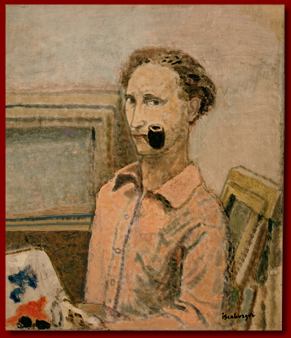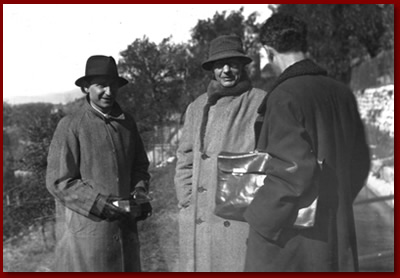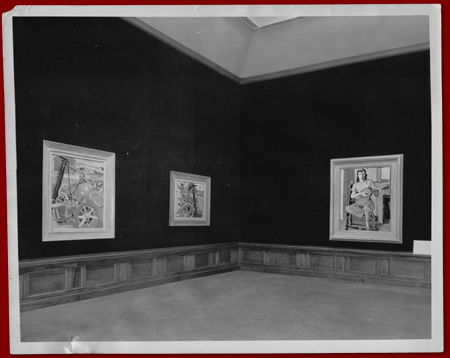 17 May 1902: Erich Isenburger b. Frankfurt am Main into a banking family
17 May 1902: Erich Isenburger b. Frankfurt am Main into a banking family
January 1908: Jula Elenbogen b. Augustow (Russia; Poland after World War I)
1920-1924: Erich studies painting at the Frankfurt art academy under Professor Franz Karl Delavilla.
1924: Six years after the end of World War I, the French authorities refuse to issue Erich Isenburger with a visa to Paris. He decides to move to Barcelona, where, in his studio and on travels through Catalonia, he produces a great number of studies and paintings.
1927: Family affairs make his return to Frankfurt am Main essential.
Erich Isenburger and Jula Elenbogen first meet at her uncle’s house in Frankfurt, where she is staying, after having left school in Poland at the age of sixteen with her parents’ consent.
In the very same year, Erich and Jula receive permission to marry from Jula’s parents and they travel to Poland for the wedding. They are married on December 10, 1927. Jula’s father dies unexpectedly during their stay in Poland.
The Isenburgers move from Frankfurt am Main to Vienna.
June 1928: They rent a studio at the Spittelauerplatz.
1928-1931: Erich and Jula live and work in Vienna.
Jula studies dance in Hellerau and then with the dancing teacher Gertrud Kraus.
Erich’s main work during the years in Vienna focuses on portraits.
The Swiss photographer M. Imboden takes impressive portraits of Jula and Erich during their years in Vienna.
1931: The Isenburgers move to Berlin.
Jula starts at the Berlin dependance of the Mary Wigman School.
The architect Joseph Neufeld designs and furnishes their studio in Paulsbornerstrasse.
Erich Isenburger develops a new painting technique. With a thin palatte knife he incises portraits and figures in dark primers.
1933: First show in the Gurltt Gallery in Berlin. The Berlin Reichstag is destroyed by fire. The gallery owner Wolfgang Gurlitt advises the Isenburgers to “take a vacation” in France, following attacks in the right-wing press on Erich Isenburger’s work.
1933-1936: Paris (rue St. Vincent, rue Cambon, rue Campagne)
Erich Isenburger’s style changes. The influence of French fauvism is evident.
Exhibition of his paintings in the Salon De Printemps, in the Salon d’Automne in the Grand Palais, Paris, and in London.
He also makes designs for Jula’s stage costumes.
Under the name Jula Geris, Jula Isenburger works as a choreographer and dancer on stage throughout France.
The talented Swedish photographer Anna Riwkin takes portraits of both artists.
1934 and 1936: Erich Isenburger has two one-man shows at Galerie Moderne in Stockholm, Sweden.
 1936-1939: Return to France and move to the south–first to Nice and then in 1939, to Grasse.
1936-1939: Return to France and move to the south–first to Nice and then in 1939, to Grasse.
Erich and Jula Isenburger visit Pierre Bonnard in Le Carnet near Cannes.
1939-1941: Erich Isenburger is interned in Les Milles and St. Nicholai. Jula is interned at Gurs.
André Gide protests openly against the internment of German emigrants.
A letter from André Gide to Eric Isenburger.
Emergency Rescue Committee co-founded by Hermann Kesten supports Erich and Jula Isenburger’s attempts to obtain an entry permit for the United States of America.
Jula and Erich Isenburger leave Europe for New York, embarking from Lisbon on the S.S. Ciudad de Sevilla. Arriving at Ellis Island, they are pressured to simplify their name Isenburger, but they resist; however, Erich becomes Eric.
Jula Isenburger gives up her dance career; she sometimes works as a salesperson at Saks Fifth Avenue when money is needed.
 1942: The first of eight one-man shows of Eric Isenburger’s works in the Knoedler Gallery, New York.
1942: The first of eight one-man shows of Eric Isenburger’s works in the Knoedler Gallery, New York.
1940’s: Eric and Jula often stay during summer in Wookstock, NY, where he paints and they meet other artists.
1949: Eric and Jula Isenburger become American citizens.
They live in New York at Central Park South, and later on the East Side of Manhattan.
After World War II, they travel extensively to Central America and back to Europe. They particularly enjoy traveling in the south of France and to Venice, but also Spain, Portugal and Southern Italy.
1962: After almost 30 years, Eric Isenburger has his second exhibition with Wolfgang Gurlitt–this time in Munich.
One-man shows of Eric Isenburger’s works in the USA take place, amongst other places, in the Baltimore Museum Of Art, Baltimore, MD; the De Young Memorial Museum, San Francisco; the Springfield Museum, Springfield, MA; the Herron Art Institute, Indianapolis; the Fine Arts Center, Colorado Springs; Mc Clee’s, Philadelphia; the Francis Taylor Gallery, Los Angeles and Associated American Artists, Los Angeles.
Group shows, amongst many others: Art Institute Of Chicago; Metropolitan Museum (NY) national competitive exhibition “American Painting Today 1950.”
Eric Isenburger receives a great number of major prizes and awards. Among the National Academy Of Design awards: Design Prize for the Outstanding Work (1945), two Edwin Palmer Memorial Prizes (1957 and 1970), two Henry Ward Ranger Purchase Awards (1957 and 1980), Thomas Proctor Prize for Best Portrait (1963), Salmagundi Club Prize (1966), Andrew Carnegie Prize (1972), Hibbard Memorial Award (1976), Saltus Gold Medal (1980), and N. Maynard Prize (1991). Among the Audubon Artists awards: Macy’s New York Award (1969), two Jane Peterson Prizes (1971 and 1978), and the Simex Award (1979). Other prizes include: third prize, Carnegie Institute, Pittsburgh, PA (1947); nationwide Pepsi Cola Annual Medal Of Honor (1948); Corcoran Gallery Of Art, Washington, DC Twenty-First Bi-Annual Exhibition, First Prize and Gold Medal (1949); American Academy And Institute Of Arts And Letters Childe Hassam Purchase Award (1955).
1980: Eric Isenburger is honored with the quinquennial Florence Brevoort Eickemeyer Award of Columbia University (NY) as the Most Deserving Artist and Teacher.
1990: Eric Isenburger’s last paintings.
1994: Eric Isenburger dies in New York a few weeks before his ninety-second birthday.
1999: “Eric Isenburger 1902-1994 Ausgewählte Werke” exhibition, Neuburg an der Donau, Germany.
2000: Jula Isenburger dies at home in New York in April, at the age of 92.